▶ 回归问题的提升树,采用分段常数函数进行回归,每次选择一个分界点及相应的两侧估值,最小化训练数据在两侧的残差平方和的和,然后将当前残差作为下一次训练的数据,最后把各次得到的分段函数加在一起,就是最终回归结果
● 代码
1 import numpy as np 2 import matplotlib.pyplot as plt 3 from matplotlib.patches import Rectangle 4 5 trainDataRatio = 0.3 6 dataSize = 1000 7 defaultEpsilon = 0.05 # 需要进行分段的最小区间宽度 8 randomSeed = 103 9 10 def myColor(x): # 颜色函数 11 r = np.select([x < 1/2, x < 3/4, x <= 1, True],[0, 4 * x - 2, 1, 0]) 12 g = np.select([x < 1/4, x < 3/4, x <= 1, True],[4 * x, 1, 4 - 4 * x, 0]) 13 b = np.select([x < 1/4, x < 1/2, x <= 1, True],[1, 2 - 4 * x, 0, 0]) 14 return [r**2,g**2,b**2] 15 16 def dataSplit(dataX, dataY, part): # 将数据集分割为训练集和测试集 17 return dataX[:part],dataY[:part], dataX[part:], dataY[part:] 18 19 def judgeStrong(x, para): # 强分类判别函数,调用弱分类判别函数进行线性加和 20 return para[1][targetIndex(x, para[0])] 21 22 def targetIndex(x, xList): # 二分查找 xList 中大于 x 的最小索引 23 lp = 0 24 rp = len(xList) - 1 25 while lp < rp - 1: 26 mp = (lp + rp) >> 1 27 if(xList[mp] >= x): 28 rp = mp 29 else: 30 lp = mp 31 return rp 32 33 def createData(count = dataSize): # 创建数据 34 np.random.seed(randomSeed) 35 X = np.random.rand(count) 36 Y = X * (32 / 3 * (X-1) * (X-1/2) + 1) 37 return X, Y 38 39 def adaBoost(dataX, dataY, weakCount): # 提升训练 40 count = len(dataX) 41 xSort, ySort = zip( *sorted(zip(dataX, dataY)) ) 42 xSort = np.array(xSort) 43 ySort = np.array(ySort) 44 45 result = np.zeros([weakCount,3]) 46 for i in range(weakCount): 47 table = np.zeros(count - 1) 48 for j in range(count - 1): # 找最佳分割点,损失函数为两侧残差平方和的和 49 #table[j] = np.sum( (ySort[:j+1] - np.mean(ySort[:j+1]))**2 ) + np.sum( (ySort[j+1:] - np.mean(ySort[j+1:]))**2 ) 50 table[j] = -np.sum(ySort[:j+1])**2 / (j+1) - np.sum(ySort[j+1:])**2 / (count - j - 1) # 简化一点计算量 51 index = np.argmin(table) 52 53 valueLeft = np.mean(ySort[:index+1]) # 两侧估值 54 valueRight = np.mean(ySort[index+1:]) 55 result[i] = np.array([ xSort[index], valueLeft, valueRight ]) # 当前结果暂存,表示当前分类器以 xSort[index] 为分点,左右侧取值分别为 valueLeft 和 valueRight 56 ySort[:index+1] -= valueLeft # 两侧新残差 57 ySort[index+1:] -= valueRight 58 59 result = np.array(sorted(result, key=lambda x:x[0])) 60 #L = np.triu( np.tile(result[:,1], [weakCount+1,1]), 0 ) # 分段结果加和为最终分类器,注意段数为 weakCount + 1 61 #R = np.tril( np.tile(result[:,2], [weakCount+1,1]), -1) # 这里第 i 行 等于 r[0] + r[1] + ... + r[i-1] + l[i] + l[i+1] + ... +l[n],表示第 i 个分点 62 #return np.concatenate(( result[:,0], np.array([np.inf]) )), np.sum(L + R, 1) # 其中第 0 行是 np.sum(result[:,1]),第 weakCount 行是 np.sum(result[:,2]) 63 L = np.concatenate(( np.cumsum(result[:,1].T[::-1])[::-1], np.array([0.0]) )) # 简化一点计算量和空间开销 64 R = np.concatenate(( np.array([0.0]), np.cumsum(result[:,2].T) )) 65 return np.concatenate(( result[:,0], np.array([np.inf]) )), L + R 66 67 def test(weakCount): # 单次测试 68 allX, allY = createData() 69 trainX, trainY, testX, testY = dataSplit(allX, allY, int(dataSize * trainDataRatio)) 70 71 para = adaBoost(trainX, trainY, weakCount) 72 73 testResult = [ judgeStrong(i, para) for i in testX ] 74 errorRatio = np.sum( np.abs(np.array(testResult) - testY) ) / (dataSize*(1-trainDataRatio)) 75 print( "weakCount = %d, errorRatio = %f"%(weakCount, round(errorRatio,4)) ) 76 77 fig = plt.figure(figsize=(10, 8)) # 画图 78 plt.xlim(-0.1, 1.1) 79 plt.ylim(-0.1, 1.1) 80 XX = [0.0] + para[0][:-1].flatten().tolist() + [1.0] 81 YY = [ judgeStrong(i, para) for i in XX ] 82 plt.scatter(testX, testY, color = myColor(1), s = 8, label = "originalData") 83 for i in range(weakCount+1): 84 plt.plot(XX[i:i+2], [YY[i+1], YY[i+1]],color = myColor(0), label = "regressionData") 85 plt.text(0.1, 1.0, "weakCount = " + str(weakCount) + " errorRatio = " + str(round(errorRatio,4)), size = 15, ha="center", va="center", bbox=dict(boxstyle="round", ec=(1., 0.5, 0.5), fc=(1., 1., 1.))) 86 R = [ Rectangle((0,0),0,0, color = myColor(1 - i)) for i in range(2) ] 87 plt.legend(R, ["originalData", "regressionData"], loc=[0.79, 0.012], ncol=1, numpoints=1, framealpha = 1) 88 89 fig.savefig("R:\weakCount" + str(weakCount) + ".png") 90 plt.close() 91 92 if __name__ == '__main__': 93 test(1) 94 test(2) 95 test(3) 96 test(4) 97 test(20) 98 test(100)
● 输出结果,包含训练轮数和预测错误率
weakCount = 1, errorRatio = 0.184200 weakCount = 2, errorRatio = 0.142200 weakCount = 3, errorRatio = 0.115000 weakCount = 4, errorRatio = 0.102500 weakCount = 20, errorRatio = 0.035300 weakCount = 100, errorRatio = 0.016000
● 画图,总数据量 1000,训练集 300,测试集 700
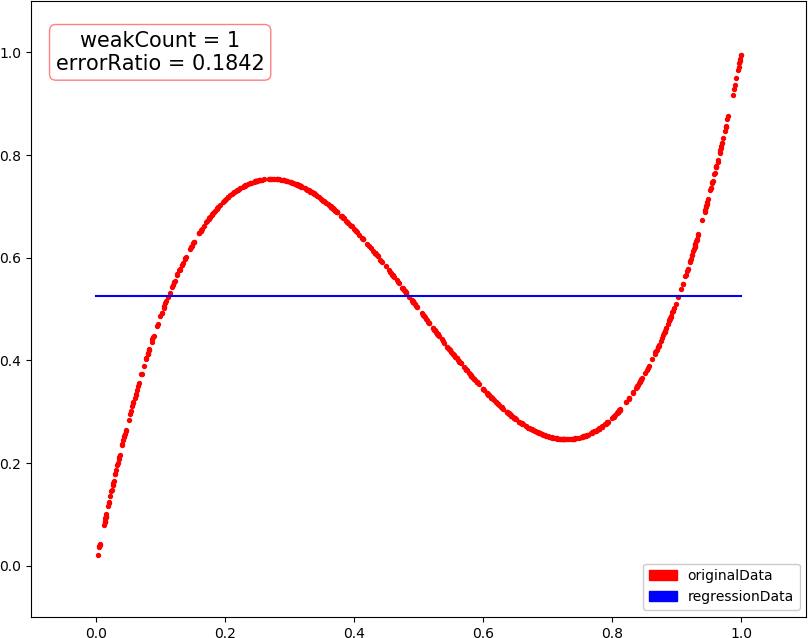
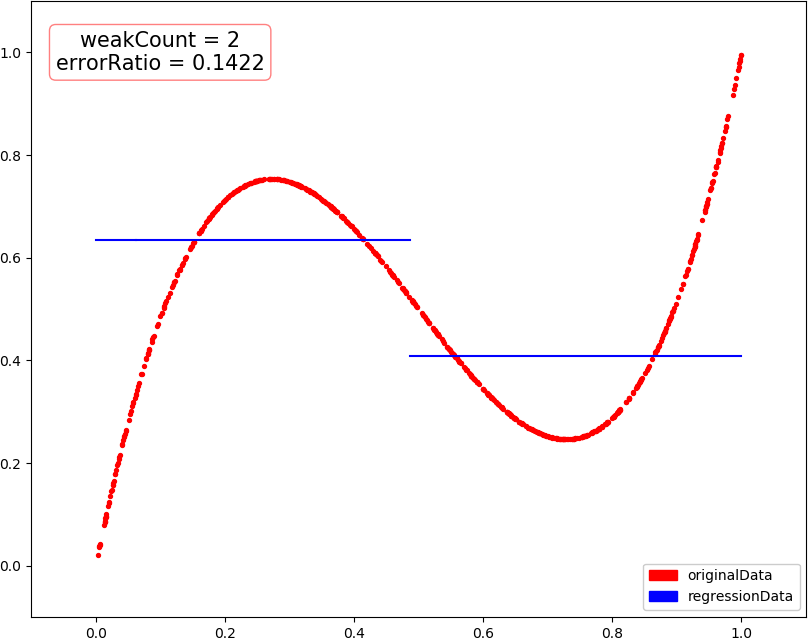
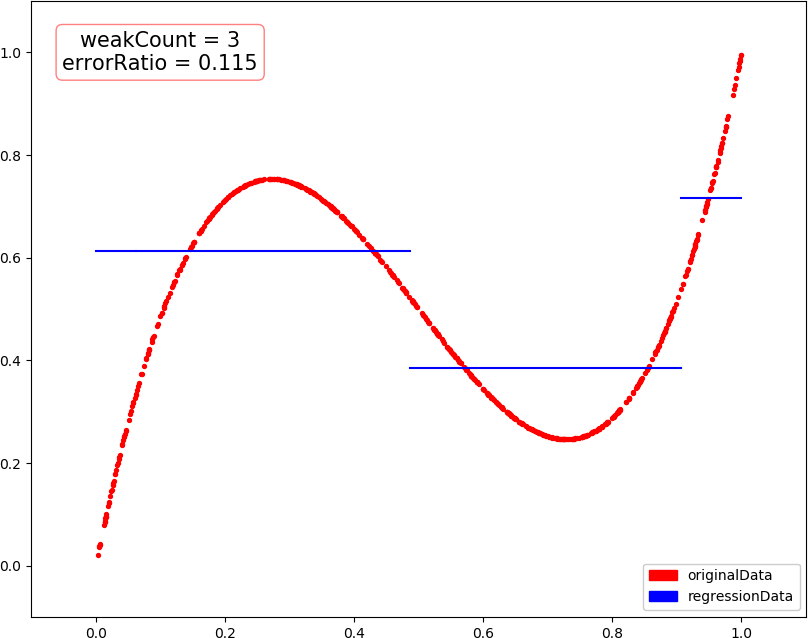
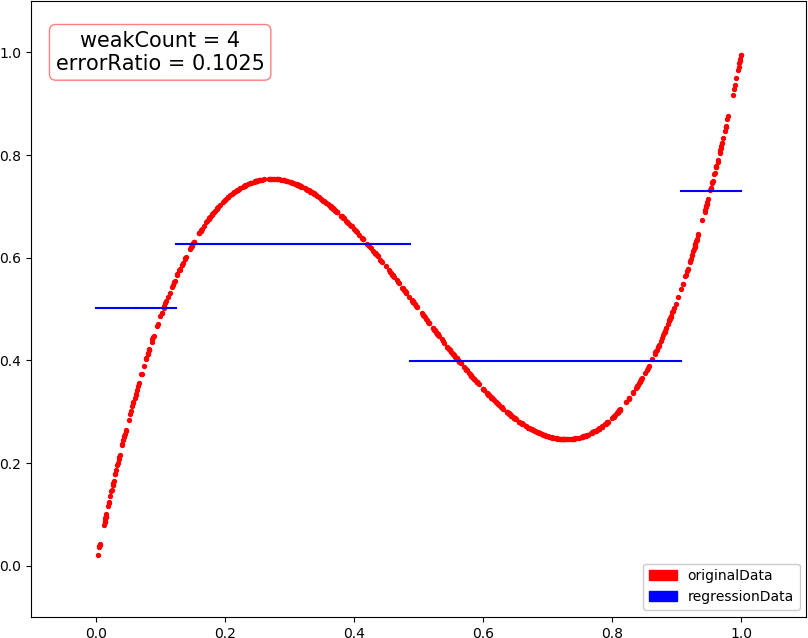

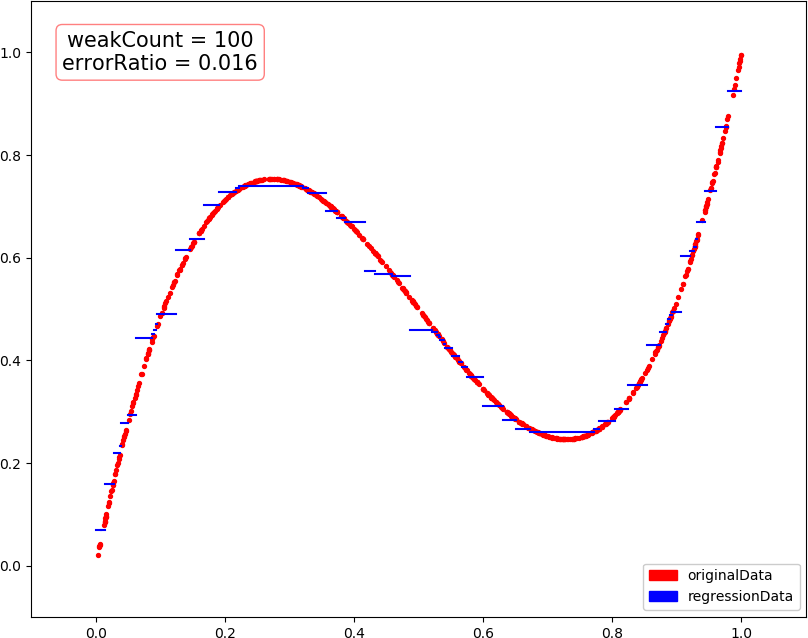
● 画图,当总数据量减为 500,训练集 150 时,出现了过拟合?
